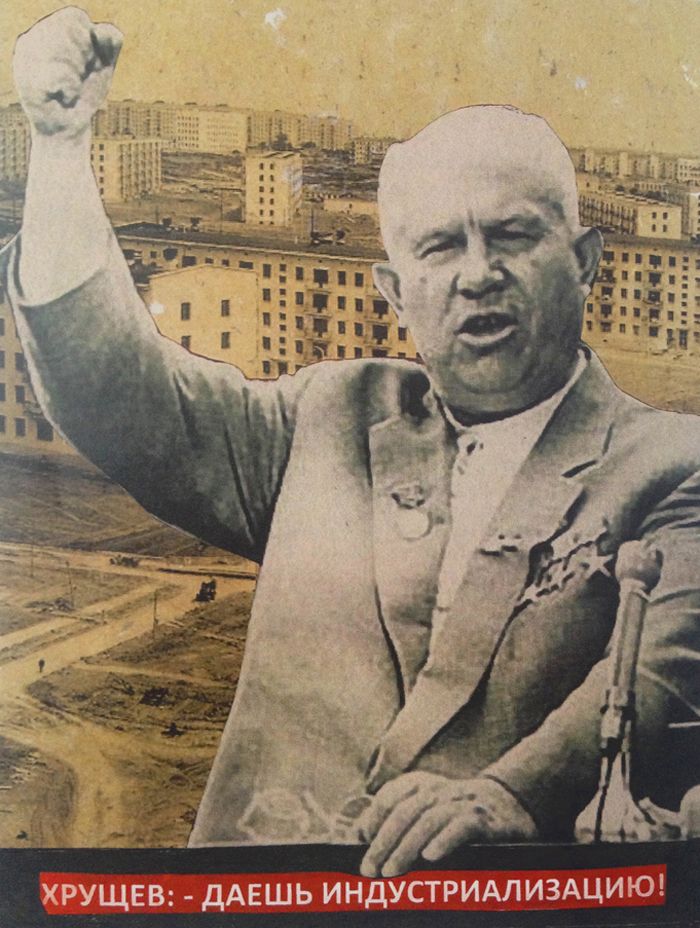Conference:
Postwar
Soviet Architecture
Salt Galata
May 11, 2013 11.00 – 17.30

“Start industrialization!”
Poster design by Felix Novikov
Poster design by Felix Novikov
SALT Galata, Auditorium
We tend to think that the history of postwar architecture and urban planning has been written. Yet upon closer observation the map of canonized perceptions of Modernism reveals a number of white areas and blind spots. Among the most fascinating is an architectural landscape that unfolded in the Soviet Union after the death of Joseph Stalin in 1953 and continued until the fall of he Soviet Empire in 1990. The period bred a highly ideological architectonical practice that was guarded by a central planning bureaucracy. But under this banner experimental architecture still blossomed and a variety of locally distinct “parallel modernities” were developed. This conference attempts to correct the one-dimensional Western view of Modernism and to demonstrate a Parallel Modernity made up of unique masterpieces, megalomanical housing structures and approaches to urban planning that imagined cities and public spaces as metaphors for socialist ideas of contemporary and future life.
Architects, who were building during the period, together with art historians and theoreticians, will reflect on how the machinery of urban planning worked, giving an insight into a very specific period of Soviet architecture. The audience will be introduced to architects that by no means produced only monotonous concrete-slab housing developments, but who in part demonstrated original approaches to urban planning and in many ways manifested thematic and design parallels with Western architectural concerns of the time.
Simultaneous translation from Russian to English will be provided for the first session of the conference; followed by simultaneous translation from English to Turkish for the second and third sessions.
PROGRAM
“What is Soviet Architecture?”
11.00-11.10 Introduction by Georg Schöllhammer
11.10-11.40 Vladimir Belogolovsky and Felix Novikov
11.40-12.00 Andrey S. Kosinskiy
12.20-12.40 Karen Balyan
12.40-14.00 Lunch break
“Socialist in Content, National in Form”
14.00-14.20 Igor Vasilevskiy
14.20-14.40 Boris Chukhovich
14.40-15.00 Marija Dremaite
15.00-15.20 Ekaterina Shapiro-Obermair
15.20-15.40 Q&A
15.40-16.00 Coffee break
“Looking Back to the Empire”
16.00-16.20 Oleksiy Radynski
16.20-16.40 Yuri Avvakumov
16.40-17.10 Keti Chukhrov
17.10-17.30 Q&A
BIOGRAPHIES
Yuri Avvakumov graduated from the Moscow Architectural Institute and has run the AGITARCH studio since 1988. Avvakumov curated and participated in the exhibitions of Paper Architecture between 1984 and 2009, and participated in the Venice Biennale three times.
Karen Balyan is an architect and a professor who specializes in 20th century architecture and design.
Vladimir Belogolovsky is the founder of New York-based Intercontinental Curatorial Project. Trained as an architect at Cooper Union in New York, he has published over 200 articles and is the author of books including Soviet Modernism: 1955-1985 (Tatlin, 2010), Felix Novikov (Tatlin, 2009; DOM, 2013), Harry Seidler: Lifework (Rizzoli, 2014).
Boris Chukhovich is an independent curator, art historian, and a specialist in modern and contemporary arts of Central Asia. Chukhovich worked at the Art History and Theory Research Institute of Arts Academy of Uzbekistan until 1998. He practices as an artist in digital media.
Keti Chukhrov is a cultural theorist and associate professor of Art Theory and Cultural Studies at the Russian State University for Humanities. Her recent book To be and to perform: The project of theater in philosophical critique of art, was published in 2011.
Marija Drėmaitė is an assistant professor at Vilnius University, Department of Theory of History and Cultural History. She holds a Ph.D. in history of architecture and co-authored Architecture in Soviet Lithuania (2012).
Andrey S. Kosinskiy graduated from the Moscow Architectural Institute in 1954. He is a professor and an honorary member of the International Academy of Architecture, Moscow Branch. In 1983 he was granted the highest award by World Biennale of Architecture Interarch-83.
Felix Novikov graduated from the Moscow Architecture Institute in 1950. Buildings he has designed include the Palace of Pioneers in Moscow and the Central Ensemble of the town of Zelenograd. He holds a Ph.D. in architecture and is a professor. Novikov has authored the books The Formula of Architecture, Architects and Architecture and Soviet Modernism 1955-1985 and 2009 his monograph Felix Novikov was published. He has been awarded the title “People’s Architect of the USSR.”
Oleksiy Radynski is a journalist and filmmaker who lives in Kiev. He is an activist for the Visual Culture Research Center and an editor of the Ukrainian edition of the Political Critique magazine. Between 2010-2012 he was a research associate for the project Soviet Modernism 1955-1991. Unknown Stories.
Ekaterina Shapiro-Obermair is a visual artist and curator in the fields of contemporary art and architecture. Significant components of her work include cultural and geopolitical references to Russia and issues of modernity. She was one of the co-curators of Soviet Modernism 1955-1991. Unknown Stories (2012) at the Architekturzentrum Wien.
Igor Vasilevskiy graduated from the Moscow Architectural Institute in 1959. Vasilevskiy worked as chief architect of the Soyuzkurortproject for more than 30 years.
On view at SALT Galata from May 8 until August 11, the exhibition Trespassing Modernities is supported by Kalebodur; the affiliated conference is supported by the İstanbul Austrian Cultural Office and tranzit.at.


Supported by
Supported by

